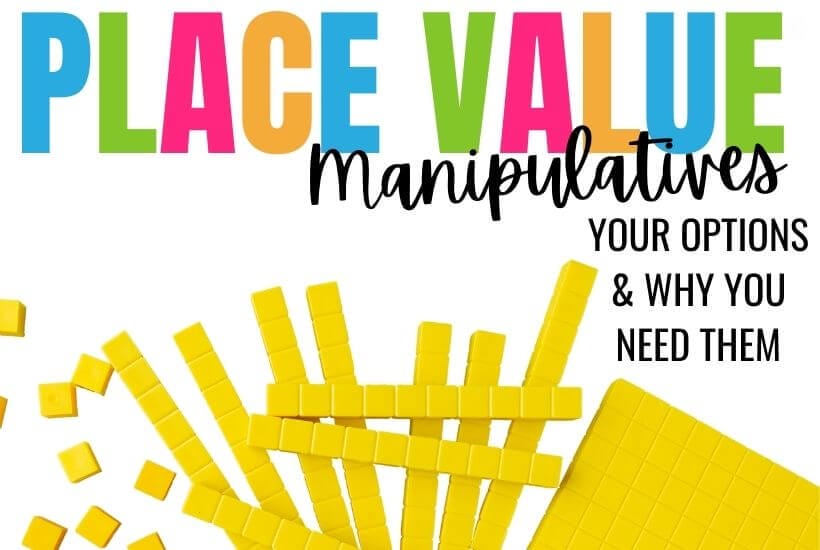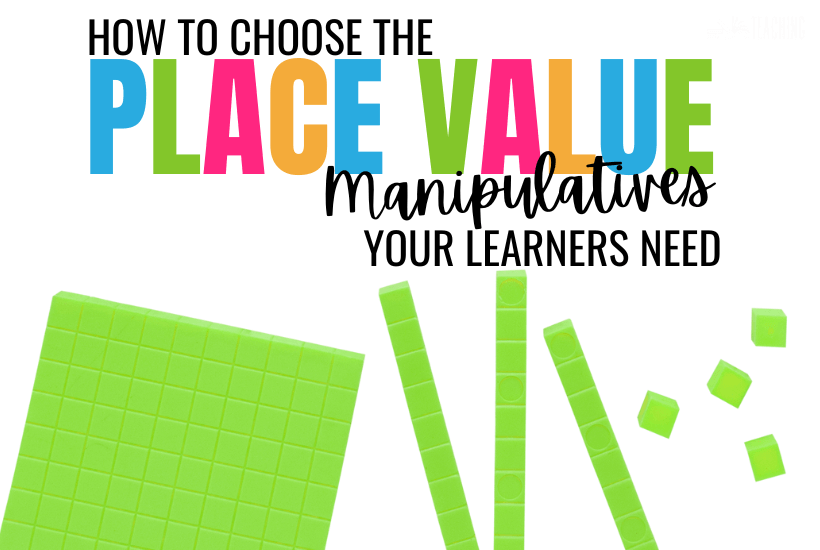Must-Have Math Manipulatives for Conceptualizing Place Value
As anyone who has ever worked with elementary-aged children knows, understanding and internalizing place value is no small feat. After all, our number system is completely arbitrary – we could just as easily have a base 8 or base 12 system. So it’s no wonder that many students struggle to wrap their heads around the concept of place value and what it actually means. This is where place value manipulatives come in.

Math manipulatives are physical objects that can be used to represent mathematical concepts. They are an incredibly powerful tool for helping students to visualize and understand complex ideas like place value.
There are many different types of manipulatives used in mathematics that can be used to teach place value. However, some of the most popular and effective ones are 10s frames, Base 10 blocks, Base 10 disks, and Digi Blocks. This blog post will explain why each of these manipulatives is so useful for teaching place value and will offer some suggestions for how to use them in the classroom.
Note: Some links in this post are affiliate links, which means I receive a commission if you make a purchase. Affiliate relationships include Amazon Affiliates.
Why are visual representations important for teaching place value?
Visuals help kids understand and remember things better. Our brains can process information much more quickly when we see pictures along with words. This means that visual representations will help students remember key ideas even after the lesson is over.
When it comes to place value, one of the main reasons why visual representations are so important for teaching place value is that they help students to see the relationships between numbers. For example, a 10s frame can help students see that the number 12 is made up of one ten and two ones. It is easier to understand than just being told that the number 10 has a value of one ten.
Another benefit of using place value manipulatives is that they help students build a foundation for computation. Regrouping is a great example! When working with Base 10 blocks, students can physically move the blocks around to regroup them in different ways. This helps them to see that regrouping is just a matter of rearranging the physical objects. Soon students realize it’s not some magical or complicated process.
Using math manipulatives to teach place value concepts can be an extremely effective way to help students understand a complex and often confusing topic.
Place Value Manipulatives & Visual Tools
Visual representations and hands-on activities are critical to helping students understand the concept of place value. Here are a few manipulatives that can be used to teach place value, along with a brief description of each one.
Tens Frame
A 10s frame is a rectangular grid made up of ten squares. The squares are usually numbered from 0 to 9, and the numbers correspond to the values in each column. For example, a number in the “tens” column would be worth 10 times more than a number in the “ones” column. 10s frames are often used with the youngest learners to introduce place value concepts. You can use them to help students understand addition and subtraction, as well.
You can easily make your own Tens Frame with a marker and paper, making it the easiest place value tool for young learners to organize numbers.
Base 10 Blocks
Base 10 blocks are a type of manipulative that is often used to teach place value and decimals. They are small rectangular blocks that are usually made of plastic or wood. They come in three different sizes, which represent the values 1, 10, and 100. For example, one Base 10 block representing the value 1 would be worth one unit, while ten of those same blocks put together would be worth one ten. Students often use these to help understand place value as well as addition, subtraction, and multiplication.
Most schools have sets of Base 10 blocks readily available. That’s because they are relatively inexpensive and effective. I’ve purchased a set on Amazon for under $8 for my own kiddos to use.
You can also find place value blocks in digital formats, like these, but be sure your students get hands-on practice by introducing the place value chart and real Base 10 blocks before moving to the digital version if possible.
Place Value Disks
These are similar to Base 10 blocks, but they are flat discs instead of rectangular blocks. Like Base 10 blocks, they represent the values 1, 10, 100, 1000, and even larger values. However, unlike their Base 10 block counterparts, place value disks are the same size regardless of their value. Therefore, they are not great for helping students who struggle to understand the magnitude of different numbers.
Place Value disks are usually made of plastic or wood. You use them as students begin working with larger numbers. You will find that this can help reduce overwhelm with those numbers that can feel very abstract to elementary learners.
Digi Blocks
Digi blocks are another great option for teaching place value of whole numbers and decimals in a way that is more concrete. They are similar to Base 10 blocks, but they remove the need for trading to regroup. Instead, students “pack” ten ones inside a tens case. You can pack the tens cases inside the “hundreds case”. This is useful for helping students to understand how the numbers relate to one another place value, as they can easily see the relationship between the physical blocks and the numerical values that they represent. For example, you can use them to easily model how many tens are needed to make 100.
Digi blocks come in a few different options, including color-coded and transparent options for differentiation. Here’s an example of a lesson where students subtract from 100 using Digiblocks.
How to pick the right manipulative for your learners
Now that you know a little bit more about some of the different place value manipulatives, it’s important to know how to choose the right one for your students. Below are some tips for choosing the best manipulative for your learners:

1. Consider the age and developmental level of your students.
If you’re working with very young learners, you’ll want to choose a manipulative that is simple and easy to use. Ten frames and Base 10 blocks are good options for younger students, who are commonly working with smaller numbers. As students get older and begin working with larger numbers, you can introduce more complex manipulatives, such as Base 10 disks and Digi blocks.
2. Consider the ability level of your students.
If you have students who are struggling to understand place value concepts, you’ll want to choose a manipulative that is more visual and concrete. Base 10 blocks, Base 10 disks, and Digi blocks are all good options for struggling students. You have a physical representation of the numbers being used with these tools!
3. Consider the learning goals you have for your students when selecting place value manipulatives.
Before you choose a manipulative, it’s important to consider what you want your students to learn from using it. If you’re looking to help your students understand the magnitude of powers of 10 you may want to utilize Digi Blocks. Alternatively, Base 10 blocks would be better a better way to reduce misconceptions than Base 10 disks, for example.
4. Consider the resources you have available.
Some manipulatives can be expensive. It can be tempting to skip practice using manipulatives or have your students draw their models instead. However, research suggests both of these practices actually impede learning.
You can find free printable math manipulatives online if you’re working with a limited budget. Consider making your own manipulatives or borrowing them from another teacher.
No matter what manipulative you choose, the most important thing is that you’re using it consistently. With a little bit of trial and error, you’ll be able to find the perfect manipulative for your students.
Mix & match these four place value manipulatives to boost learning
As you begin to plan your place value unit, consider how you’ll provide more opportunities for hands-on learning this year. While you might think that older students don’t need concrete representations, research shows that these manipulatives can help all learners move from concrete to abstract understanding more easily.
Manipulatives provide an opportunity for students to move beyond rote memorization of place value concepts to a deeper understanding of our number system. The National Council of Teachers of Mathematics (NCTM) recommends the use of manipulatives as an instructional strategy for grades Pre-K–12 because “they offer students a concrete way to represent and solve problems, helping them link concepts and procedures.”
As your unit progresses, if your students are having trouble with place value concepts and understanding the relationship between digits in larger numbers, take a step back. It may be time to bring out the manipulatives!








